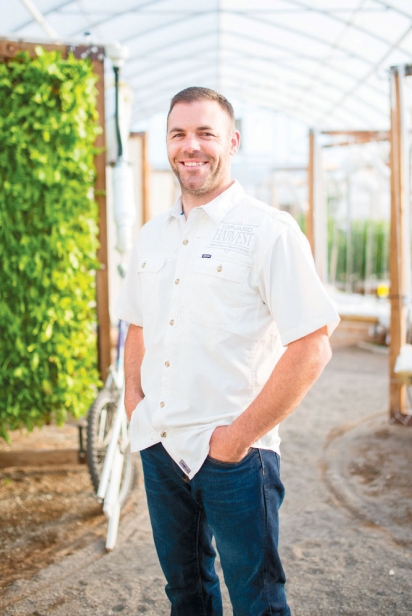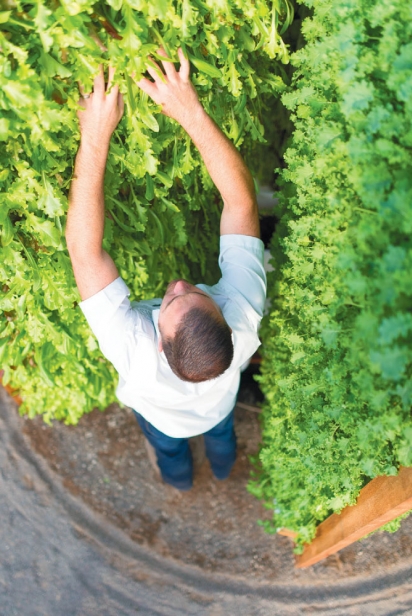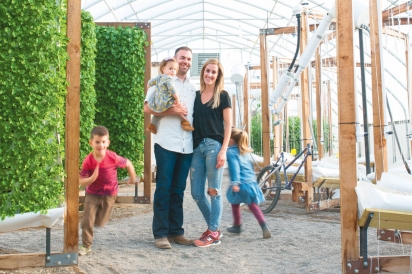Upward Harvest
Let’s take a Wikipedia break to go over some basics. We’ll start with aquaculture, which is the raising of aquatic animals. Hydroponics is cultivating plants in water. The marriage of these two practices is aquaponics—a system that Travis Flatt of Upward Harvest has used to engineer his greenhouse, leading to the creation of not only tasty produce and herbs, but also sound, movement, energy, and life.
Company Name: Upward Harvest
Name: Travis Flatt
Website: www.upwardharvest.com (Instagram & Facebook) @upwardharvest
Where can we find Upward Harvest produce?
We are currently in these local grocery stores: Buy For Less, Crest, Uptown Grocery, and Homeland. You can also find our products on many local restaurant menus.
How did you get into farming?
I worked on my grandparents’ farm as a kid growing up in Stroud, OK. My mom and grandma taught me how to tend a garden, take care of farm animals and how to fish. My grandpa taught me how to do things like mow/weed-eat, drive a tractor, use a chainsaw, split firewood, and kill snakes in the chicken coop. I learned most of the basics from them (but I’m still afraid of snakes).
What is the driving factor behind the type of farming you do and products you grow?
We want to bring honor to God and serve our community with the works of our hands and the crops we produce. In order to do that, we have developed the most efficient and sustainable methods of farming to date. We have taken what works from dozens of industries and brought them together to make farming practical. The crops we currently grow are based on what’s in demand. And we always want to have a very diverse crop offering for the sake of risk mitigation and farming sustainability.
What do you grow on your farm?
We are currently growing: two varieties of heirloom beefsteak tomatoes, six different artisan cherry tomatoes, slicing cucumbers, hops, blue oyster mushrooms, kale, lettuce medley, basil, cilantro, sage, chives, dill, parsley, five types of mint, oregano, rosemary, thyme, lavender, and marjoram. And tilapia, of course.
How did you choose these items?
We think crop diversity goes along with sustainability. If a farm relies on just 2 or 3 crops, it is susceptible to failure for a multitude of reasons. And since we don’t use chemical nutrients or commercial pesticides, we need to have a wide range of crops to keep the pests at bay.
How do you think fresh produce impacts a dish?
It’s hard to describe unless you’ve had (truly) fresh produce from an organic garden. We’ve had elderly folks tell us our tomatoes remind them of the tomatoes their parents grew. Their eyes light up when they bite into a tomato bursting with flavor. Then they begin to rave about how much better it is than what they are used to buying. And seeing our 5, 3 and 1 year-old kids fight for the last slice of cucumber assures us that there is something unique about how we grow—the flavor is easy to appreciate. A dish prepared with fresh produce doesn’t need to be smothered in dressing—it’s just good by itself.
What’s a unique use for fresh herbs that people might not think of?
We like to enjoy fresh herbs in our water—a heathy drink with almost limitless flavor options. They can also be used on top of a mid afternoon snack like crackers and cheese, with something like a little sprig of fresh dill. Or a Caprese salad topped with some fresh basil. Fresh herbs can add an exciting dynamic to almost any dish or adult beverage.
What unique challenge does growing in Oklahoma give you?
Farming in Oklahoma blesses us with the experience to grow in weather extremes like no other. We’ve always said that Oklahoma weather is preparing us to grow in any climate around the world. We’ve grown through the coldest, negative 25 degree winters and hottest, 105 degree summers. Hail, wind, snow, ice, earthquakes, tornados, you name it. One of the most memorable times came this past winter: it was Christmas Eve and a fire had to get started in order to keep our fish warm and our plants happy. It’s a daily chore through the winter months. So my 5-year-old son and I were starting a fire in the dark in the pouring rain in temperatures just above freezing. Pretty awesome (not really). Thankfully, I had the best flashlight holder a dad could ask for.
Tell us a bit about what sets Upward Harvest products apart?
This is likely to sound cliché but we feel like everything we do sets our products apart. We’ve developed our technology and farm to grow certified organic products around what plants and animals truly need. Our products enjoy natural sunlight, natural nutrients, water capturing, water conservation, and an active eco-system. Or perhaps its what we don’t do that sets us apart. We don’t use chemicals for nutrients, we don’t use LED or grow lights, we don’t spray pesticides on our farm or on our crops, we don’t use GMO seeds, we don’t pollute the environment with CO2 generators, and our farms don’t cost millions of dollars to deploy. We’ve spent the past five years creating an urban farming concept that just works. And it works really, really well.
This issue of Edible OKC is focusing on water. Tell us about your unique way of nourishing your plants?
We use a rather new growing technique called aquaponics. It’s the combination of aquaculture and hydroponics. This form of farming capitalizes on two really efficient farming practices while removing the negative aspects of each method. Beyond the efficiency of aquaponics, we’ve developed and patented a revolutionary growing technology that allows us to grow a wide range of crops on a really small footprint of land. Our ‘Growing Structures’ are water powered, spinning in circles throughout the day, utilizing natural sunlight and natural nutrients to grow nutritious produce in abundance. Yes, we use 90% less water than traditional agriculture, and that’s great. But we also put our water to work in a way that brings beauty to agriculture, showcasing nature like never before.
You say that you can grow a wide range of crops on a small footprint, can you give us an example?
Yes, our structures can grow just about anything. Tomatoes, cucumbers, peppers, strawberries, melons, grapes, lettuce, kale, herbs, squash, zucchini, eggplant, gourds, okra, peas, and hops. Within the next 18 months (through further development) we’ll also be able to grow root veggies like potatoes, onions, beets, carrots, garlic, and radishes as well. As far as volume goes, we are currently growing 2,400 leafy green plants in just 196 square feet.
When you started to design your growing structures, what values did you have in mind when choosing the materials?
We wanted to build them out of materials that were locally sourceable anywhere in the world. For instance, our drive mechanism that turns the structures to provide light to all of the plants is made of bike parts and a PVC water lever. We chose materials that you could run to the store and grab if you had to or that you could find in any third world country. No machines, no gears, no pulleys, no motors, and very minimal power is required to run our system. This results in a very low cost, high efficiency growing system. Our growing structures will generally pay for themselves from just one crop.
Where do you hope to see Upward Harvest expand and grow in the future?
We want to feed people nutritiously organic food at an affordable cost. And honestly, we’d love to do that wherever the Lord lets us. We hope to see Upward Harvest locations across the country—but for now, we’re starting in Oklahoma and we’ll see where our reach can extend from here. Beyond that, we will soon be selling the cleanest, most humanely raised tilapia around. Tilapia serve a very important role as the ‘engine’ of our growing system, but they also reproduce like crazy. Therefore, fish for sale! No growth hormones, no antibiotics, just good, clean fish.
Any tips for the average person who might want to start their own backyard garden?
I’d say go for it! There’s nothing quite like the joy of picking your own produce that you grew on your own property. And if you need help, give us a call. We can provide everything from simple consultation to complete custom growing systems to fit your application. Soon we will also be licensing our technology to other commercial growers outside our region to help further our mission to bring local, organic, affordable food to the masses.
Thank you, Travis, for sharing about your farm!








